catalytic converter AUDI A3 2011 Owner´s Manual
[x] Cancel search | Manufacturer: AUDI, Model Year: 2011, Model line: A3, Model: AUDI A3 2011Pages: 320, PDF Size: 75.79 MB
Page 5 of 320
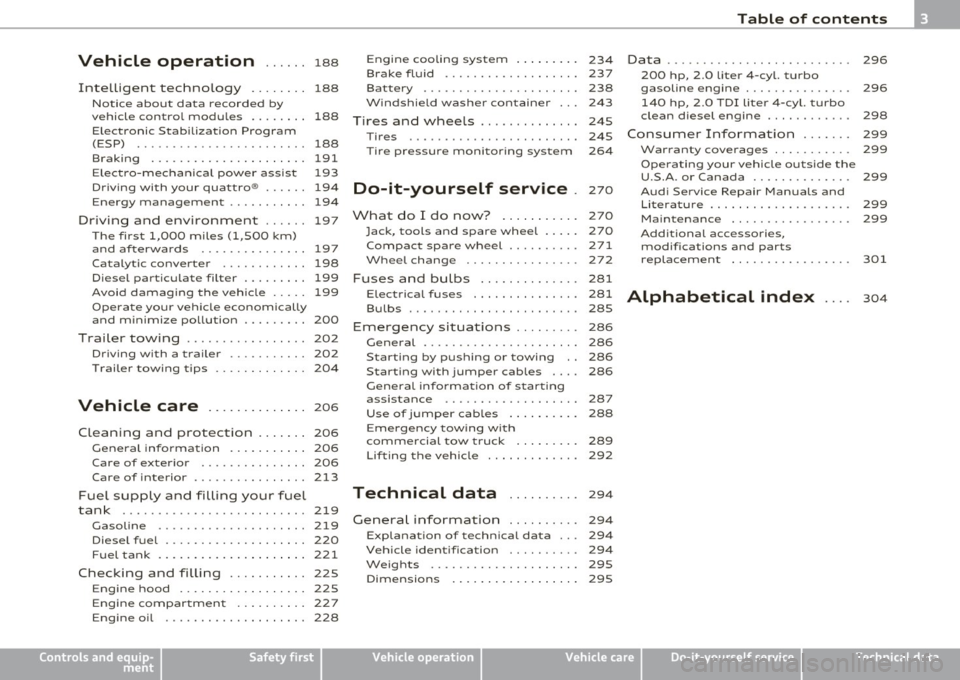
Vehicle operation ...... 188
Inte lligent tec hno logy ....... . 188
Notice abou t da ta recorded by
vehicle control modules . . . . . . . . 188
Electronic Stab ili z ati on Program
(ESP) ................ ........ 188
Braking ...................... 191
E lec tro-mec hanic al power assist 193
Dr iving with your qua ttro ® ...... 194
Energy management ........ ... 194
D rivi ng a nd env iro nm ent ...... 197
T he firs t 1,000 miles (1,500 km)
and af terwa rds ............... 197
Catalytic converter ...... ... ... 1 98
Diesel part iculate filter ......... 199
Avoid damaging the veh ic le ..... 199
Opera te your veh ic le econom ically
and m inimize pollution . . . . . . . . . 200
Trailer towing ................. 202
Driving with a trailer . . . . . . . . . . . 202
Trailer towing tips . . . . . . . . . . . . . 204
Vehicle care .......... .... 206
Cleaning and protect ion .. ..... 206
G eneral informat ion . . . . . . . . . . . 206
Care of exterior . . . . . . . . . . . . . . . 206
Care of interior ........... ..... 213
F uel sup ply and filling y our fuel
tank ....... .............. ..... 219
Gasoline ..... ......... ....... 219
Diesel fuel . . . . . . . . . . . . . . . . . . . . 220
F u el tank . ... ......... ........ 221
Checking and filling ........... 225
Engine hood . . . . . . . . . . . . . . . . . . 225
E ngine compartment .......... 227
E ngi ne oil . . . . . . . . . . . . . . . . . . . . 228
Controls and equip
ment Safety first
Engine
cooling sys tem . . . . . . . . . 234
Brake fl uid ................... 237
Battery . . . . . . . . . . . . . . . . . . . . . . 238
Windshield washer container . . . 243
T ires and whee ls .............. 245
T ires . . . . . . . . . . . . . . . . . . . . . . . . 245
Tire pressure monitoring system 264
Do-it-yourself service . 270
What do I do now? . . . . . . . . . . . 270
Jack, tools and spa re whee l . . . . . 270
Compac t spare wheel .......... 271
Wheel change ................ 272
Fuses a nd bul bs . . . . . . . . . . . . . . 281
E lec trica l fuses ............... 281
Bulbs ........................ 285
E merg ency si tuati ons . . . . . . . . . 286
G eneral . . . . . . . . . . . . . . . . . . . . . . 286
Starting by pushing or towing
Starting with jumper cables ....
General info rma tion of starting
assistance .................. .
Us e of j umper cab les ......... .
Emergency tow ing w ith
comme rcial tow truck ........ .
Lif ting the vehic le ............ .
Technical data
General in formatn on
Explanation of technical data .. .
Vehicle identification ......... .
Weights .................... .
Dimensions 286
286
287
288
289
292
294
294
294
294
295
295
Table of contents
Data .
. . . . . . . . . . . . . . . . . . . . . . . . . 296
200 hp , 2.0 liter 4-cyl. turbo
gasoline engine . . . . . . . . . . . . . . . 296
140 hp, 2.0 TOI l iter 4-cyl. turbo
clean diesel engine . . . . . . . . . . . . 298
C o nsumer Inform ati on . . . . . . . 299
Warranty coverages . . . . . . . . . . . 299
Operating your vehicle outside the
U.S.A. or Canada . . . . . . . . . . . . . . 299
Aud i Service Repair Manuals and
Li tera ture . . . . . . . . . . . . . . . . . . . . 299
Maintenance . . . . . . . . . . . . . . . . . 299
Add itional accessories,
modif ications and parts
replacemen t . . . . . . . . . . . . . . . . . 301
Alphabetical index . . . . 304
Vehicle operation Vehicle care Do-it-yourself service Technical data
Page 22 of 320

Driver information display
• Gear shift recommendation can be deactivated in the dr iver infor
mation system~
page 22. •
On-Board Diagnostic system (OBD)
On-Board Diagnostics
Fig. 9 Location of
Data Link Connector
(DLC)
On-Board Diagnostics monitors the components of your emission
control system. Each controlled component in your eng ine system
has been assigned a code. In case of a malfunction, the component
wi ll be identified and the fault stored as a code in the control module
memory .
The MIL lamp may also illuminate if there is a leak in the on-board
fuel vapor recovery system.
If the Light illuminates after a refuelling,
pull off the road and stop the vehicle, then check that the fuel filler
cap is properly closed~
page 222.
In order to make an accurate diagnosis, the stored data can only be
displayed using special diagnostic equipment (generic scan tool for
OBD).
In order to connect the special diagnostic equipment, push the plug
into the Data Link Connector (DLC). The DLC is located to the right of
the engine hood release lever~ fig. 9. Your authorized
Audi dealer or a qualified service station can inter
pret the code and perform the necessary repair.•
Malfunction Indicator Lamp (MIL) (USA
models) / (Canada models )
The Malfunction Indicator Lamp (MIL) in the instrument cluster
~ page 11, fig. 5 is part of the On-Board Diagnostic (OBD II) system.
T he warn ing/indicator light illum inates when the ignition is switched
on and goes out after the engine starts and the idle has stabilized.
This indicates that the MIL is working properly .
If the light does not go out after the engine is started, or illuminates
while you are driving, a malfunction may exist in the engine system.
If the light illuminates, the catalytic converter could be damaged.
Continue driving
with reduced power (avoiding sustained high
speeds and/or rapid accelerations) and have the condition corrected.
Contact your authorized Audi dealer.
If the light illuminates, the electronic speed limiter may also be
ma lfunction ing. For more information~
page 20, "E lectronic speed
limiter" .
An improperly closed fuel filler cap may also cause the MIL light to
illuminate~
page 222 . •
Electronic speed limiter
Your vehicle may be factory equ ipped with tires that are rated for a
maximum speed of 130 mph (210 km/h). This is less than the
maximum speed of your veh icle . To reduce the risk of sudden tire
fai lure and loss of control if the vehicle is operated at excessive
speeds, your vehicle a lso has an electronic speed limiter . The elec
tronic speed limiter prevents your vehicle from going faster than the
tire speed rating. For more information~
page 259, "Speed rating
(letter code)".
~
Page 200 of 320
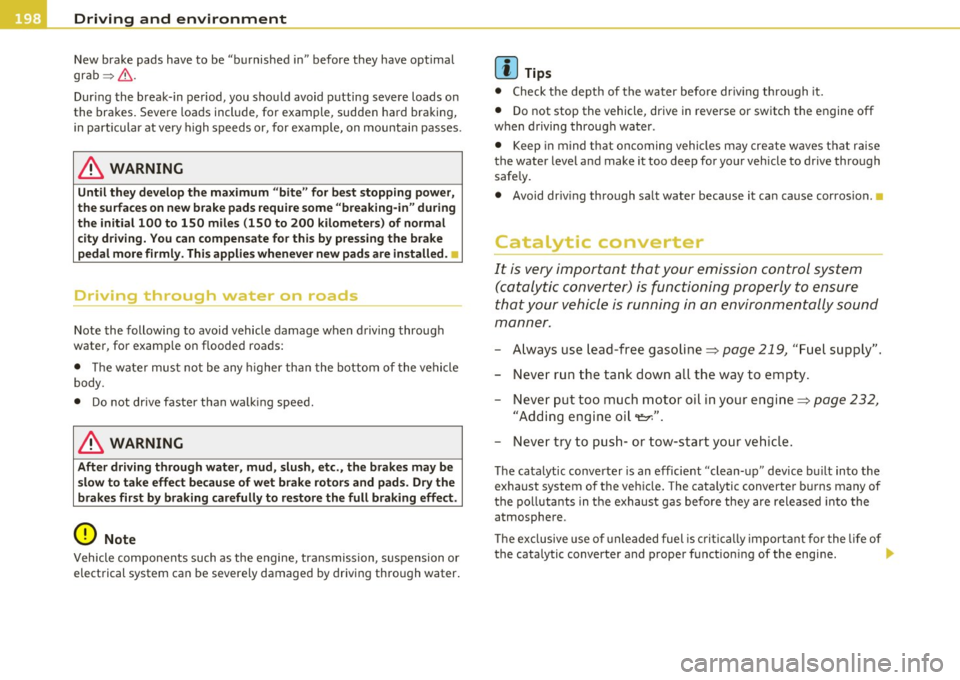
Driving and environment
New brake pads have to be "burnished in" before they have optimal
grab ~& .
Dur ing the break-in period, you should avoid putting severe loads on
the bra kes. Severe loads incl ude, for example, sudden hard braking,
in part icu lar at very high speeds or, for examp le, on mountain passes .
& WARNING
Until they develop th e ma ximum "bite " for b est stopp ing pow er,
the surfaces on new brake pads require some "breaking-in" during
the in itial 100 to 150 mile s (150 to 200 kilometers ) of normal
city dr iving. You can compensate for this by p ress ing the brake
pedal more firml y. Thi s applies whenever n ew pads are in stalled .•
Driving through water on roads
---
N ote the following to avoid vehicle damage when driving through
water, fo r example on flooded roads:
• Th e wate r mus t not be any higher th an the bottom of the ve hicl e
body.
• Do not dr ive faster t han wal king speed.
& WARNING
After driving through water, mud , slush, etc ., th e brak es may be
slow to take effect because of wet brake rotors and pads . Dry the
brakes first by braking carefully to restore the full braking effect .
0 Note
Vehicle components such as the engine, transmission, suspension or
electrical system can be severely damaged by driving thro ugh water.
W Tips
• Check t he dept h of the wa ter before dr iv in g thro ugh it.
• Do not stop the vehicle, drive in reverse or sw itch the engine off
when driving through wate r.
• Keep in m ind t hat on coming vehicles may cre ate w aves t hat raise
the water level and make it too deep for your vehicle to drive thro ugh
safe ly.
• Avoid dr iv in g through sa lt water because it can cause corros ion. •
Catalytic converter
It is very important that y our emiss ion con trol system
(ca talyti c converte r) is func tioning pr operly to ensure
that your vehicle is running i n an environm entally sou nd
manner.
- Always use lead-fre e gasoline => page 219, "Fu el supply".
- Never run the ta nk down a ll the way to empty .
- Never p ut too much mo tor o il in your engine=>
pag e 232,
"Adding engine oil~" -
- Neve r try to pu sh- or tow-start you r vehicle.
T he catalytic converter is an efficient "clean- up" device b uilt into the
exhaust system of the veh icle. The cata lytic converter b urns many of
t he poll uta nts in the e xhaust g as before they are released in to the
atmosphe re.
Th e ex clusive use o f unleaded fuel is c ritic ally impor tant for the life of
the cata lytic converte r and proper f unction ing of the engi ne. ..,
Page 201 of 320
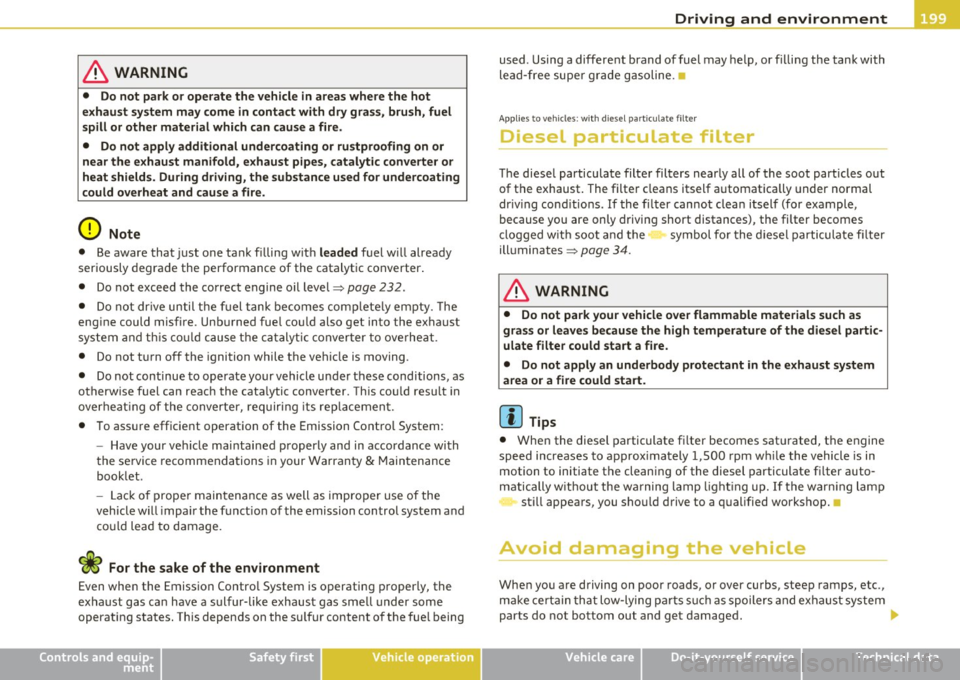
_____________________________________________ D _r_ i_v _i_,ng and environment
& WARNING
• Do not park or operate the vehicle in areas where the hot
exhaust sy stem may come in conta ct with dry gra ss, bru sh, fuel
s pill or oth er mater ial wh ich can caus e a fire .
• Do not apply additional under co ating or ru stproofing on or
near the exhaust manifold, exhaust p ipes, catalytic converter or
heat shield s. During driving, the sub stance u sed for undercoating
c ould overheat and cause a fire .
0 Note
• Be aware that j ust one tank fi lling w it h le aded fuel w ill already
seriously degra de the performance of the catalyt ic converter .
• Do not exceed the correct engine o il leve l~
page 23 2.
• Do not dr ive until t he f uel tank be comes comp lete ly empty. The
eng ine could misfire . Unburned fue l cou ld also get into the exhaust
sys tem and t his co uld cause t he ca talyt ic conver ter to ove rhe at.
• Do not t urn off the ignition while the vehicle is moving .
• Do not continue to operate your vehicle under these conditions, as
otherwise fuel can reach the cata lytic converter. This cou ld resu lt in
over heat ing of the converter, req uir ing its rep lacemen t.
• T o ass ure efficient operation of the Emission Contro l System :
- Have your ve hicle maintai ned properly and in accordance with
t he se rvi ce recommenda tions in your Warran ty
& M ain tenance
book let .
- Lack o f prope r mai ntena nce as well as improper use of the
vehicle w ill impa ir the f unct io n of the emission control system and
co uld lead to damage .
<£> For the sake of the environment
Even when the Emission Contro l System is operating p roperly, the
exhaust gas ca n have a sulfur-like exhaust gas smell under some
ope rating states. This depends on the s ulfur content o f the fue l being
Controls and equip
ment Safety first Vehicle operation
used
. Using a differe nt brand of fuel may help, or filling the tank with
lead-free supe r grade g asoline .•
A pp lies to ve hicle s: with d ie se l pa rtic ul at e f ilte r
Diesel particu ate filter
The diese l particulate filte r filters nearly all of the soot part icles out
of the exhaust. The filte r cleans itself a utomat ically under normal
dr iv ing cond itions . If the fi lter cannot clea n itself (for example,
because you are only driving short distances), the filter becomes
clogged w it h soot and the symbol fo r the diese l particulate fi lter
ill uminates ~
page 34.
& WARNING
• Do not park your vehicle over flammable materials such as
grass or leaves because the high temperature of the diesel partic
ulate filter could start a fire .
• Do not apply an underbody prot ectant in the exhaust system
area or a fire could start.
[I) Tips
• When the diesel partic ulate f ilter becomes sat urated, the engine
speed increases to approx ima tely 1 ,S00 rpm w hile the vehicle is in
motion to initiate t he cleanin g of the diesel particulate fi lter auto
matically w it h out the wa rning lamp ligh ting up. If the war ning lamp
st ill appears, you sho uld drive to a qualified workshop. •
Avoid damaging the vehicle
When you are driving on poor roads, or ove r curbs, steep ramps, etc .,
m ake ce rta in t hat low-ly ing pa rt s such as spoilers and exhaust system
parts do not bottom out and get damaged.
Vehicle care Do-it-yourself service Technical data
Page 203 of 320
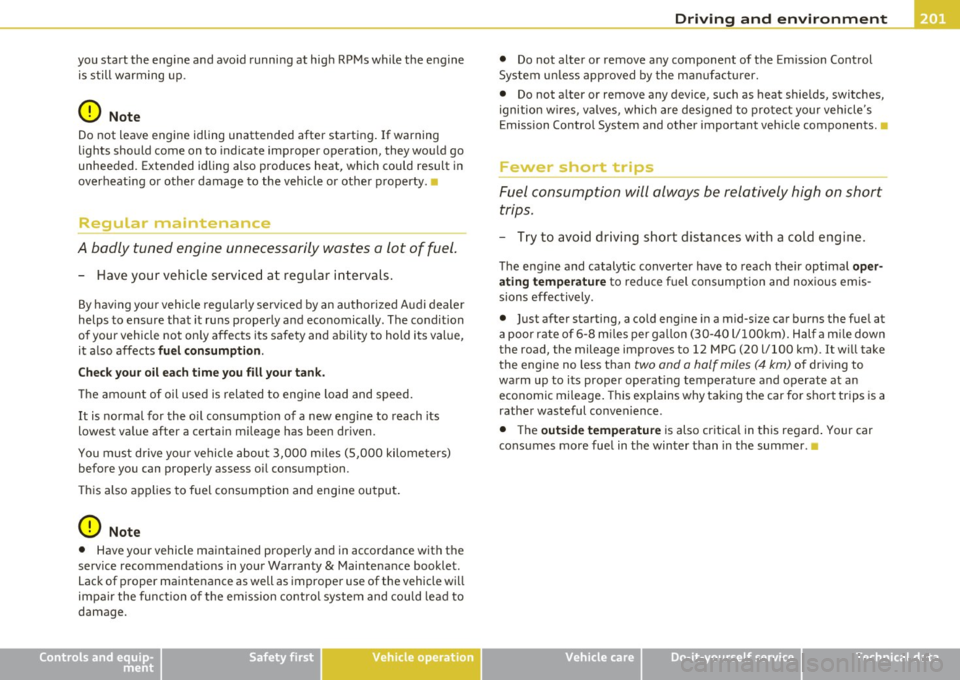
Driving and environment
------------------------------------------------'
you start the engine and avoid running at high RPMs while the engine
is still warming up.
0 Note
Do not leave engine idling unattended after starting. If warning
lights should come on to indicate improper operation, they would go
unheeded. Extended idling also produces heat, which could result in
overheat ing or other damage to the vehicle or other property.•
Regular maintenance
A badly tuned engine unnecessarily wastes a lot of fuel.
- Have your vehicle serviced at regular intervals.
By having your vehicle regularly serviced by an authorized Audi dealer
helps to ensure that it runs properly and economically. The condition
of your vehicle not on ly affects its safety and ability to hold its value,
it also affects
fuel consumption .
Check your oil each time you fill your tank.
The amount of oil used is related to engine load and speed.
It is normal for the oil consumption of a new engine to reach its
lowest value after a certain mi leage has been driven.
You must drive you r vehicle about 3,000 miles (5,000 kilometers)
before you can properly assess oil consumption.
Thi s also applies to fuel consumption and engine output.
0 Note
• Have your vehicle maintained properly and in accordance with the
service recommendations in your Warranty
& Maintenance booklet.
Lack of proper maintenance as well as improper use of the vehicle will
impa ir the function of the emission control system and could lead to
damage.
Controls and equip ment Safety first Vehicle operation
•
Do not alter or remove any component of the Emission Control
System unless approved by the manufacturer.
• Do not a lter or remove any device, such as heat shie lds, switches,
ignition w ires, va lves, which are designed to protect your vehicle 's
Emission Control System and other important vehicle components.
Fewer short tr ips
Fuel consumption will always be relatively high on short
trips.
- Try to avoid driving short distances with a cold engine.
The engine and catalytic converter have to reach their optimal oper
ating temperature
to reduce fuel consumption and noxious emis
sions effectively .
• Just after starting, a cold eng ine in a mid-size car burns the fuel at
a poor rate of 6-8 miles per gallon (30-40 l/l00km). Half a mile down
the road, the mileage improves to 12 MPG (20 l/100 km). It will take
the engine no less than
two and a half miles (4 km) of driving to
warm up to its proper operat ing temperature and operate at an
economic mileage . This explains why taking the car for sho rt trips is a
rather wasteful convenience .
• Th e
outside temperature is also critical in this regard . Your car
consumes more fuel in the winter than in the summer.
Vehicle care Do-it-yourself service Technical data
Page 215 of 320
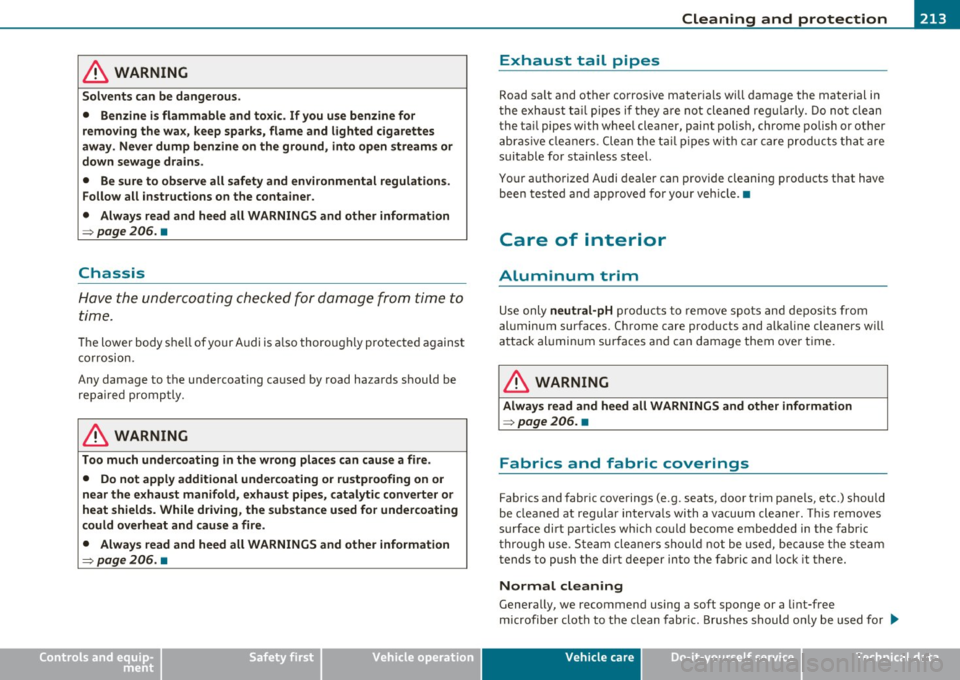
Cleaning and protection -
---------------=---------=----
& WARNING
Solvents can be dangerous.
• Be nzine is flammabl e and toxic. If you u se benzine for
remo ving the wa x, keep sparks , flame and l ighted cigarettes
away . Never dump benzine on the ground , into open stream s or
down sewage drains .
• Be sure to ob serve all safety and environmental regulation s.
Follow all instruct ions on the container.
• Always read and heed all WARNINGS and other information
=>page 206 . •
Chassis
Have the undercoating chec ked for damage from time to
time.
Th e lower body she ll of your Audi is a lso thoro ugh ly protected against
co rrosion.
Any damage to the unde rcoating caused by road hazards shou ld be
repa ire d pro mptly.
& WARNING
Too much undercoating in the wrong places can cause a fire .
• Do not apply additional undercoating or ru stproofing on or
near the exhaust manifold, exhaust pipes, catalytic converter or
heat shields. While driving , the sub stance us ed for undercoating
could overheat and cause a fire .
• Always read and heed all WARNINGS and other information
:::>page 206 . •
Safety first
Exhaust tail pipes
Road sa lt and other corrosive mater ials will damage the material in
t he exh aust tail pipes if they a re not cleaned reg ula rly. Do not clean
the ta il pipes with wheel cleaner, pai nt polis h, chrome po lish or other
abras ive clean ers . Cle an the t ail pipes wit h car ca re product s that are
suitable for sta inless steel.
You r authorized Audi dealer can provide cleaning products that have
been tested a nd app roved for your veh icle. •
Care of interior
Aluminum trim
Use only neutral-pH produc ts to remove s pots an d de pos its from
aluminum surfaces. Chrome care products and alka line cleaners w ill
attack aluminum surfaces and can damage them over time.
& WARNING
Always read and heed all WARNINGS and other information
=>page 206. •
Fabrics and fabric coverings
Fabrics and fabr ic coverings (e.g. seats, door trim pane ls, etc.) shou ld
be cleaned at regula r in terva ls with a vacuu m cleaner. T his removes
surface di rt part icles which co uld become embedded in the fabr ic
t hrough use . S te am cleaner s sho uld n ot be use d, bec ause t he s te a m
tends to push the dirt deeper into the fab ric and lock it there.
Normal cleaning
Genera lly, we recommend using a soft sponge or a lint-free
microfiber cl oth to t he clean fab ric. Brushes should o nly be used for ..,.
Vehicle care Technical data
Page 224 of 320
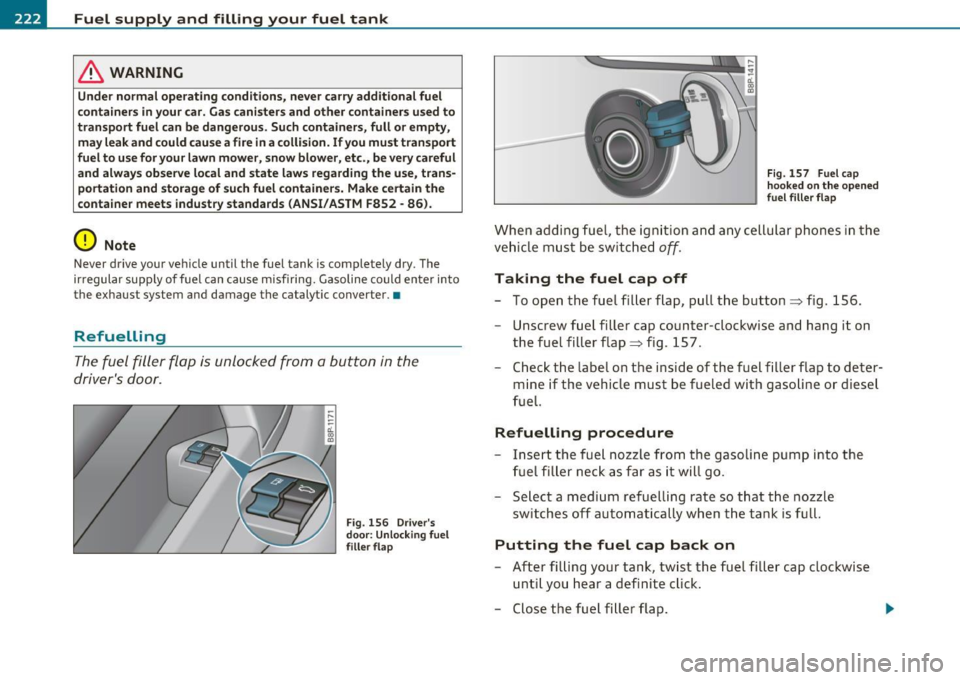
-Fuel supply and filling your fuel tank PHf_ -:.....:.-.:._____ --------=-.:-___________ _
& WARNING
Under normal operating conditions, never carry additional fuel
containers in your car. Gas canisters and other containers used to
transport fuel can be dangerous. Such containers, full or empty,
may leak and could cause a fire in a collision. If you must transport
fuel to use for your lawn mower, snow blower, etc., be very careful
and always observe local and state laws regarding the use, trans
portation and storage of such fuel containers. Make certain the
container meets industry standards (ANSI/ASTM F852 - 86).
0 Note
Never drive your vehicle until the fuel tank is completely dry. The
irregular supply of fuel can cause misfiring. Gasoline could enter into
the exhaust system and damage the catalytic converter. •
Refuelling
The fuel filler flap is unlocked from a button in the
driver's door.
Fig . 156 Driver's
door: Unlocking fuel
filler flap Fig
. 157 Fuel cap
hooked on the opened
fuel filler flap
When adding fuel, the ignition and any cellular phones in the
vehicle must be switched
off.
Taking the fuel cap off
- To open the fuel filler flap, pull the button=> fig. 156 .
- Unscrew fuel filler cap counter-clockwise and hang it on
the fuel filler flap => fig . 157.
- Check the label on the inside of the fuel filler flap to deter
mine if the vehicle must be fueled with gasoline or diesel
fuel.
Refuelling procedure
Insert the fuel nozzle from the gasoline pump into the
fuel filler neck as far as it will go.
- Select a medium refuelling rate so that the nozzle
switches off automatically when the tank is full.
Putting the fuel cap back on
-After filling your tank, twist the fuel filler cap clockwise
until you hear a definite click.
- Close the fuel filler flap. .,
Page 307 of 320

_____________________________________________ A_ L .... p_ h _ a_b_ e_ t_ ic_a_ l_ in_ d_e _ x __ _
Audi Service Repair Manuals and Literature
299
AUTO
Climate controls ..... .. .. ....... ..
98
Switching on ........... .. .. .. .. .. 98
When should I use AUTO? . .. .... .. .. 98
Auto Safety Hotline .... .. .. .. .. ..... 133
Automatic air recirculation ......... .... 99
Automatic belt retractor .......... .. . 139
Automatic car wash
See Washing ....... .. .. .. .. .... . 207
Automatic headlights
defective .............. ..........
36
Automatic Transmiss ion
Automatic Transmiss ion .. .. .. .... .
118
Automatic transmission ........... .. . 115
Driving Notes . ...... .. .. .. .. ..... 117
Emergency program .... ..........
121
Emergency release ............ ... . 121
Ignition key safety lock ....... ... .. 106
Kick-down ..... ......... ... .. .. . 120
Launch Control Program .. .. .. .. .. . 120
Selector lever lock ... .... .. .. .. .. . 116
Selector lever positions ..... .... .. . 115
Tiptronic .................... ... . 119
T iptronic controls on the steering wheel .
120
Average fuel mileage ........ ... .. .. .. 21
Average speed ......... ...... .. .. .. .. 21
Avoid damaging the vehicle .. .. .. .. .. . 199
Controls and equip
ment Safety first
B
Battery
... .. ... ... ................. 238
charging . .. .. .. .... .... .. .. ..... 241
Disconnecting and connecting ...... 238
Important warnings when work ing on the
battery ..... ........... ...... ..
239
Low . .. .. .. .. .... .... .. ......... 194
Replacing the battery .. .. .. .... ... 242
State of charge ..... .. ... ...... .. 194
Winter operation ..... ..... ....... 239
Working on the battery .... .... .... 239
Battery voltage .. ........... ...... .. . 35
Before driving .. ... .... .. .. .. .. .....
125
Bioethanol
Engine preheater .... ....... ......
103
Blended gasoline ................. .. 219
Body cavity seal ing . ...... .. .........
212
Booster seats . .. .. ...... ........... 17 5
Brake assistant . ................. ...
193
Brake booster ... .. .... .. .. .. ... ... . 192
Brake fluid
Changing the brake fluid ......... ..
238
Checking the brake fluid level ..... .. 237
Reservoir .. .. .. ... ..... ......... 237
What is the correct brake fluid level? . 23 7
What should I do if the brake fluid warning light comes on? . ... ... ..........
237
Brake pads .. .. .. .... ....... ...... .. 197
Brake system .. .. .. ........ ......... 237
Anti-lock brake system . .. .. ..... ... 16
Brake fluid . ................ ..... 23 7 Brake fluid specifications for
refill and
rep lacement .................. .
238
Brake light defective ....... .... .. .. 36
General information ............ .. 191
How does moisture or road salt affect the
brakes? ... .... .. ..............
191
Malfunction ........ ...... .... .. .. 32
Warning/indicator lights ... .... .. .. 15
Worn brake pads symbol ........... 35
Break-in period ... .. .. .... ... ..... ..
197
Brake pads .. .............. ...... 197
Tires ... ...................... .. 197
Bulbs ................ .. .. .. .... .. . 285
C
California Proposition 65 Warning .. .. . 227
Battery specific .. ................ 241
Capacities ............ ...... .... ... 296
Car care ... ..... ........... ........ 206
Interior ........... .. . .. .. .. .. .. . 213
Plastic and vinyl .. .. ............. . 210
Weatherstrips ........ .... .... .. . 211
Care of exterior . ...... .. . .. .. .. .. .. . 206
Cargo area
See Loading the luggage compartment ..
131
Cargo net ............. ...... .. .. .. .. 83
Catalytic converter .. .. .... .......... 198
Center armrest . .. ... ................ 79
Centigrade
Switching between Centigrade and Fahrenheit . .............. ...... .
99
Vehicle operation Vehicle care Do-it-yourself service Technical data
Page 310 of 320

-Alphabetical inde x _...,___ _ ______:_:__:_=.:..:...._ _________________ _
Emergency release for selector lever ... 121 Engine hood
Emergency starting ...... .. .. .. ... .. 286 Closing
............. ... .. ... .... 226
Emergency towing . .. .... .. ..... .... 289 Release lever
.............. .... .. 225
Energy management ........ .. .... .. 194 Releasing and open
ing .. .... .... .. 225
Battery power ................. .. 196 Engine malfunction (diesel engine)
Dr iver not ification .... ..... ....... 196 Warning light ............
.. .. .. .. 13
Engine E
ngine oil ........ ...... .... .. .. ... 228
4-cylinde r diesel (140 hp) ...... ... 228 Add
ing ... ... .. .. .. .. .... .. .. ... 232
4-cylinder gasoline (200 hp) . ..... . 227 Add
itives . ... ... ... .. .... .. .. ... 232
Coolant ................ ...... .. 234 Changing
....... ... .... .. .. .... . 232
Hood . ............. .... .. .... .. 225 Checking the engine oil leve
l ..... .. 231
Preheater .... .. .. .. .... ......... 103 Diesel engine .........
.... .. ..... 233
Starting . .. ... ... .... .. .. ... 106, 107
Starting w ith jumper cables . ....... 286
Stopping .. .. ... ... .. ........ ... 108
Engine compartment .. ....... ... . .. . 227
Safety instructions ............. .. 226
Work ing in the eng ine compartment 226
Engine coo lant system . ....... ... . ... 234
Add ing coolant ....... .. ... .... .. 236
Checking coo lant level ... .. .. .. ... 235
Checking the engine coolant level . .. 235 Indicat
ions and conditions requir ing extra
c heck ing .. .................... 231
O il cons ump tion . .... .. .. ... .. .. . 230
Oil grades .... .. .... ...... .. ... . 228
Recommended oil check intervals . .. 231
Specification and viscosity .. .... .. . 228
Specifications D iese l engine . .. ..... 233
Specifications gaso line engine . .... . 228
Engine oil leve l ... .. .... .. .. ...... .. . 3 4
E ngine oil p ressure (mailf u nctio n) ... .. . . 33
Radiator fan ............ ...... .. 237 Engine oil sensor defective
... .. .. ... .. 35
Engine coo lant tempe ra tur e E
ngine preheater ........ .... .. ..... 103
Ga uge ... .. .. .. .. .. .. ... . .. .. .. .. 9 Connecting ................
.... . 103
E ngine coo ling system Engine speed lim
itation . .... ... .... ... 34
Malf unct io n .. ... ......... .... .... 32 Environment
E ngine data ................ ...... .. 296 Brea
k-in period .. .... .. .. ... .... . 197
Engine fau lt
W arning light ........... ...... ... 13 Catalytic converter . . . . . . . .
. . . . . . . 198
Diesel particulate filter ............ 199
Disposing of your vehicle battery . .. . 242
Dr iv ing at hig h speeds .......... .. 200 Dr
iv in g to mi nimize pollution and noise ..
20 0
Fuel . ... .. .. .. ...... ... .. .. . ... 222
Fue l economy . ... .. .. .. ... .... .. 200
Leaks under yo ur vehicle ... .. .. .. . 226
Letting the vehicle stand and warm up ... 200
Proper disposa l of dra ined br ake fluid 238
Proper disposa l of dra ined engine coo lant
236
Prope r disposal of dra ined engine oil 232
Recycl ing used eng ine o il .......... 232
Unleaded fue l ............. .. .. .. 219
W hat sho uld I do w it h an old batte ry?
242
EPC
See Electronic power control . . . . . . . . 13
ES P
See Elect ronic Stability P rogram .. .. 188
Event Data Recorder ( EDR) .. ......... 188
Exhaust ta il pipes
Cleaning ... .... .... .. .. ...... .. 213
Expans ion tank .. ... ................ 235
F
Fahrenheit
Switching between Fahre nhe it and
Centigrade ..... .. .............. 99
Fan Adjusting the fan s peed .. ......... 1 00
Climate cont rols . ... .. .. ... .. ... . 10 0
Radiator ... .. ... ..... ... ...... .. 237